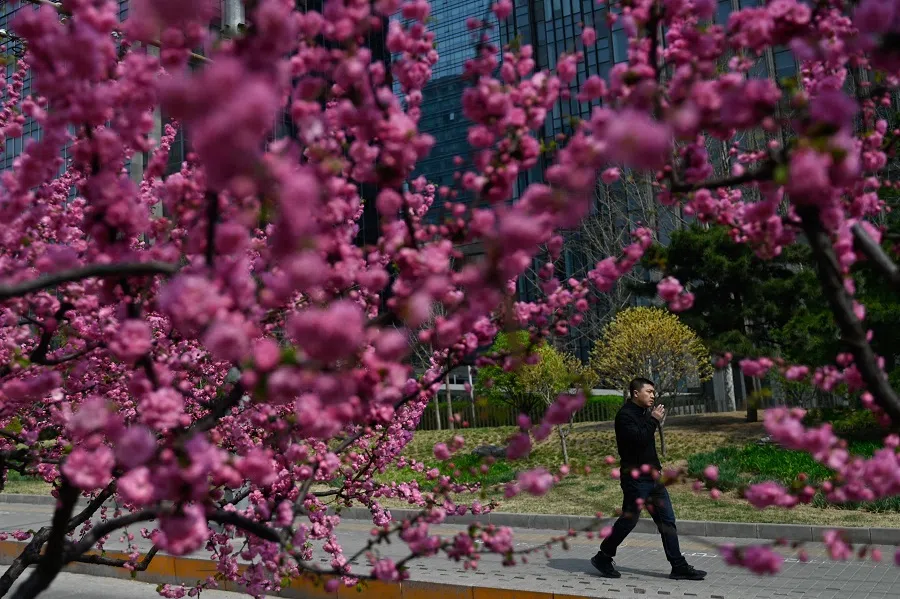Why China's debt-ridden local governments left trillions of special bond proceeds unused
PIIE researcher Tianlei Huang explains how local governments did not make the best of the local special bond programme, a major instrument of fiscal stimulus after the pandemic in 2020. He considers if the programme needs to be downsized, and resources possibly channelled to other areas such as building human capital.

The fiscal situation of local governments across China is worsening amid the property crisis. Once a main source of their fiscal revenue, land sales have been on the decline for more than two years now. Compared with the peak in 2021, land sale revenue in 2023 was one-third lower. Tax revenue from land and property development has also dropped substantially.
Due to the continuous drop in revenue, many local governments are now struggling to repay their off-budget debt (also called "hidden debt" in China) that is raised outside of the formal fiscal system through local government financing vehicles (LGFV). Many localities, with the approval of Beijing, have issued special refinancing bonds to repay some LFGV debt since last year. Amid a looming debt crisis, some local officials are reportedly resorting to unconventional sources of revenue through, for example, ramping up law enforcement to collect larger fines for traffic offences.
Nonetheless, there is a puzzling phenomenon: local governments across China have accumulated more than one trillion RMB in unused special bond proceeds since 2020. Why?
My own estimate is that at least 1.75 trillion RMB was left unused between 2020 and 2023, about 11.5% of all such bonds issued during this period.
The anomaly in local government finance
Local governments have been allowed to issue such special bonds to finance capital investment, especially in infrastructure, with certain return prospects since 2015. It is meant to encourage localities to bring their off-budget borrowing, which is costly and risky, back on budget. That way the central government can also maintain better control of fiscal policy by itself, given local governments' massive off-budget activity can make it difficult for Beijing to adjust its macroeconomic policy stance when needed.
The local special bond programme did not turn into a major instrument of fiscal stimulus until the outbreak of the pandemic in 2020. Between 2020 and 2023, local governments issued more than 15 trillion RMB in special bonds, higher than the amount of sovereign bonds that the central government issued over the same period.

However, many local governments did not invest the proceeds in eligible projects in a timely manner, leaving the money unused in government coffers for months and even years in some cases while incurring interest costs. Given the lack of national data on the use of special bond proceeds, there is no way to determine exactly what shares of local special bond proceeds were left unused. My own estimate is that at least 1.75 trillion RMB was left unused between 2020 and 2023, about 11.5% of all such bonds issued during this period.
Yet local governments, especially in less developed inland provinces, simply cannot find enough projects that can meet Beijing's requirements to invest with the special bond funds...
To a large extent, local governments left some of their special bond proceeds untouched because of Beijing's insistence that local special bonds be used only for infrastructure and public welfare-related projects that would generate enough returns to cover interest payments on the bond issues. The rationale for this condition is of course to avoid wasteful investment that only adds to the government's debt, but not much to the economy's productive capacity, a mistake that some localities have repeatedly made in the past.
Yet local governments, especially in less developed inland provinces, simply cannot find enough projects that can meet Beijing's requirements to invest with the special bond funds, partly because of their overinvestment in infrastructure in previous decades. Some local governments inflated return prospects when issuing special bonds, only to find themselves in a bind when they had to repay their debt.
The central government has pushed local authorities to find more eligible investment projects in recent years. It has also taken some technical measures, such as distributing part of the following year's special bond quotas in advance, in order to allow local governments more time to find eligible projects. Despite Beijing's efforts, the lack of eligible projects remains the underlying bottleneck in translating special bond quota into actual government investment.
Repeated underutilisation of local government special bond issues in recent years significantly undermined the effect of Beijing's intended fiscal stimulus. It raises a bigger question: should local government special bonds continue to be employed as a major instrument of fiscal stimulus? Perhaps the programme should be downsized, to make room for more effective fiscal tools like sovereign bond issuance.
... most human capital development projects, like those supporting left-behind children in rural China, probably cannot generate any cash returns so they would not meet the requirement on return prospects to use local special bonds.
The need to redirect fiscal resources toward the Chinese people
Despite diminishing returns from its outsize investment in infrastructure construction, China continues to spend massive resources in the area. An estimate shows that more than 60% of the local special bond funds issued since 2019 have been invested in infrastructure projects, including transportation, energy, and logistics, and only 12% has been spent on social areas like education, eldercare and healthcare.
In fact, most human capital development projects, like those supporting left-behind children in rural China, probably cannot generate any cash returns so they would not meet the requirement on return prospects to use local special bonds. For these projects, more suitable fiscal tools would be treasury and local government general bonds which do not have restrictions on return prospects and can be repaid with budgetary resources (tax revenues).
China should lower the annual local special bond quota and make room for more central or local general bond issues to spend on these people-related areas. The total size of bond issues would stay unchanged, only the composition changes. But such an adjustment could make a big difference potentially.

All in all, it is time for China's policymakers to reflect on this approach and consider redirecting more fiscal resources toward investing in the Chinese people. These efforts could include providing more direct support for households, strengthening the social safety net and developing human capital.
Investing more in those areas would yield long-term benefits for the Chinese economy. First, it would empower Chinese consumers and help address the structural imbalance in the economy. China has an abnormally high share of investment in GDP and an overly low share of consumption. To put its economy on a more sustainable path of growth, consumption by households and the government needs to go up. Greater cash and/or in-kind transfers to households from the government can play a critical role in raising private consumption.
Furthermore, when it comes to human capital, China still lags well behind other successful East Asian modernisers when they first started to converge toward high-income levels. Given the size of the Chinese population is on a path of long-term decline, it only makes sense for China to invest more in its people to improve human capital.





